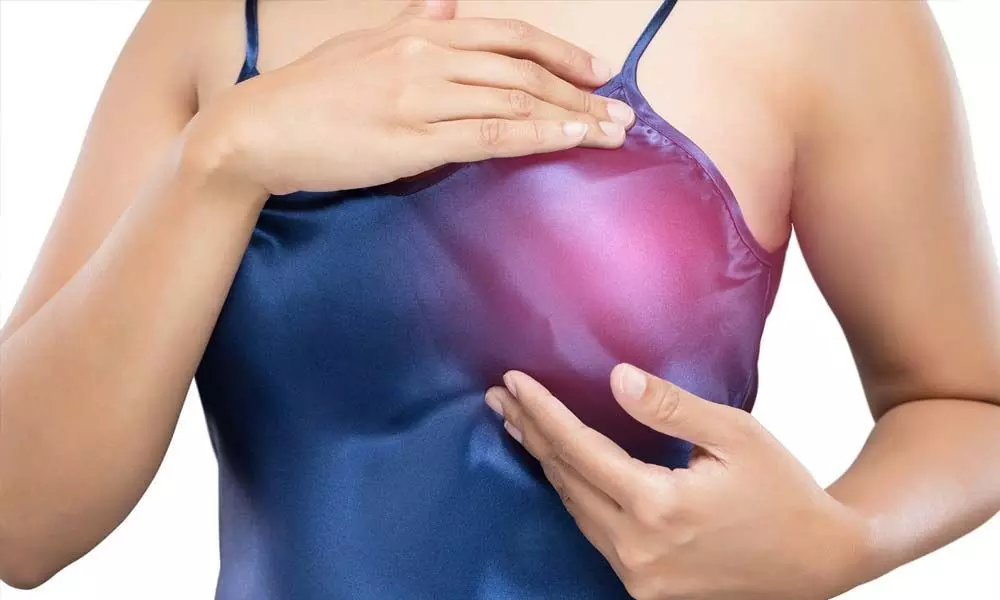Breast health is very important, Support your pair

Here's why it may help: Fat cells produce estrogen, and high levels of that hormone have been linked to certain cancers.
Exercise! Exercise! Exercise
Here's why it may help: Fat cells produce estrogen, and high levels of that hormone have been linked to certain cancers. Working out can shrink the size of fat cells, so your body pumps out less estrogen. The American Cancer Society recommends getting at least 150 minutes of moderate-intensity exercise per week (ideally, spread out, not all at once). Any kind of cardio will do, so hop on your bike or hit the nature trail. If your time is limited, exercising at high intensity for 75 minutes a week will have the same benefit.
Chocolate indulgence
As if you needed another excuse! Researchers have discovered a compound in dark chocolate that may fight fast-growing cancers. "The compound interacts with an enzyme, which causes cancerous cells to die but leaves normal cells alone," The finding may one day even lead to adding some chocolate to current cancer treatments. In the meantime, it gives you a good reason to enjoy a square.
Never ignore a Lump
It's easy to freak out if you find something during a self-exam—or to go into denial and do nothing. Here's some perspective: Four out of five lumps felt in the breast are benign, Many times a new bump turns out to be a cyst, or fluid-filled sac, associated with hormonal fluctuations. Though a new lump is probably not cancer, get it checked out by your doctor, just in case.
Fill your plate with veggies
The one thing it's pretty much OK to pig out on is produce, and now it turns out that eating your vegetables and fruit may actually help curb cancer. Several recent studies have suggested that eating a lot of fruit and veggies may be associated with a lowered risk for developing estrogen-receptor-negative breast tumors. The effect may be due to the fact that produce tends to be rich in carotenoids, natural pigments that often serve as antioxidants. Estrogen-receptor-negative breast cancers make up only about 15 percent of all breast cancers, but they're particularly hard to treat. The USDA advises that you fill half your plate with produce.
Make sure you drink less Alcohol
Sure, there's a positive health buzz around booze, but a meta-analysis of 53 studies showed that women who drank more than three drinks a day had 1.5 times the risk of developing breast cancer as did nondrinkers. Try to keep it to one serving a day or less: 12 ounces of beer, 5 ounces of wine or 1.5 ounces of hard liquor.
A good sleep enhances your breast health
Staying up late can result in greater exposure to light at night, which suppresses melatonin levels. That can be a problem because research suggests melatonin may help regulate estrogen. Another reason to turn in early and get seven to eight hours.
Folic acid for breast is mandatory
Not eating enough folate, the naturally occurring form of folic acid, is linked with impaired ability to repair DNA. And damaged DNA has, in turn, been linked to cancer. Folate is found in foods such as spinach and black-eyed peas, as well as in folic-fortified cereals and grains. Try to get 400 micrograms daily.
Learn to tame your stress with simple given techniques
Say ahhh! It's not just soothing—it could potentially be lifesaving. Some research suggests that psychological factors may be linked to increased risk for cancer, possibly because people under stress may tend to turn to alcohol or overeating in an attempt to cope with the pressure. Learn how to tame your tension with these three easy everyday techniques.
A. Take deep belly breaths. This slows and elongates brain waves, bringing on calm.
B. Watch your favourite comedy. Enjoying a good laugh activates the areas of the brain that govern humor, in turn suppressing the brain's stress regions.
C. Adopt an uplifting mantra. Try "I love my life" and repeat it when you're happy. That will train your mind to associate the phrase with being content. Then, when you're on edge, chant your mantra and you'll immediately feel more at ease.
Dark grapes for breast care
The skin of grapes may have anticancer properties. Although the research isn't definitive yet, the antioxidant resveratrol, which is found in grapes, may protect your cells from damage that could lead to cancer. And yes, that's the same resveratrol that other studies have suggested may have heart-health benefits as well. So make a point of reaching for either unsweetened grape juice or whole grapes as a healthy snack.
Know your breast well
While self-exams haven't been shown to decrease the number of breast cancer fatalities, the National Cancer Institute does say that it's important to be familiar with how your breasts usually look and feel. That way, you'll be better able to spot any changes so you can report them to your doctor. If you want to do self-exams, the best time is whenever your breasts are not swollen or tender (as they are for many women before or during their period).
Always maintain a healthy weight
Who doesn't already have this on her to-do list? But here's an even more compelling reason not to let the number on the scale creep up: Extra pounds equals an increase in estrogen production. To protect yourself, stay within the healthy range for your height. Go to Self.com/calculatorsprograms to find your body-mass index, one way to help determine your ideal weight.
Regular breast screening is very important
Every woman is different, so we've included both the basic rules by age for protecting your pair and some special circumstances that may require a closer watch.
20s: Clinical breast exam Get one every three years, according to the American Cancer Society (ACS). Your ob/gyn can perform it during your regular appointment. Breast self-exams typically play a small role in finding breast cancer, but it's fine to do them if they give you peace of mind. They can help familiarize you with the look, feel and monthly shifts of your breasts, making it easier for you to spot changes.
30s: Clinical breast exam Continue to get one every three years. If you have a family history of breast cancer—especially in a close relative like a parent or sibling—talk to your physician about when you should start getting regular mammograms or MRIs, as she may want you to start now rather than later. Be sure to tell her not only which relatives have had breast cancer but also at what age they first developed it.
40s: Mammogram and clinical breast exam The ACS recommends that women get a yearly mammogram screening starting at age 40. The U.S. Preventive Services Task Force, however, advises most women to wait another decade and get a mammogram every two years. If you haven't yet, discuss your risk factors and lifestyle choices with your doctor to determine the best schedule for you. Clinical breast exams should now be yearly.
50s and up: Mammogram and clinical breast exam Continue to get both of these screening tests annually for the rest of your life, the ACS recommends. Although some experts do put an upper limit on how late in life you should keep getting your annual mammogram, the ACS advises that all women continue to have one every year throughout their entire lives, just as long as they remain reasonably healthy for their age.















